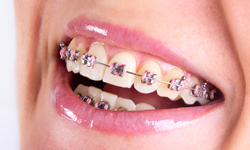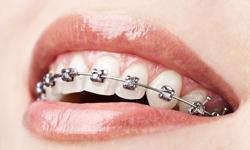Traditional Metal Braces

Traditional metal braces are the most common type of braces and are more comfortable today than ever before. Made of high-grade stainless steel, metal braces straighten your teeth using metal brackets and archwires. With metal braces, you have the option of adding colored elastics (rubber bands) for a more unique and colorful smile.
Self-Ligating Braces

Self-ligating braces are made from the same materials as traditional braces. However, self-ligating braces do not require the use of elastics, meaning fewer appointments and less friction being placed on the tooth. Self-ligating braces come with traditional metal, ceramic, or clear brackets. They are the same size as metal braces, but use a specialized clip in place of elastics to help the archwire guide teeth into place. The clip helps reduce the amount of pressure being placed on the tooth, and requires fewer adjustments because there are no elastics to replace.
Clear Aligners

Clear aligners are a series of invisible, removable, and comfortable acrylic trays that straighten your teeth like braces. Not only are the aligners invisible, they are removable, so you can eat and drink what you want while in treatment, plus brushing and flossing are less of a hassle. The aligners are comfortable and have no metal to cause mouth abrasions during treatment.
Clear (Ceramic) Braces

Advantages to clear braces:
- Appearance: Ceramic braces and clear braces are much less noticeable than traditional metal braces. Clear and ceramic braces offer an aesthetic alternative for patients seeking options other than traditional metal braces.
- Confidence: Many patients who choose ceramic or clear braces feel more confident about their orthodontic treatment, especially knowing that people are focusing on their smiles rather than their braces.
Disadvantages to clear braces:
- Cost: Ceramic and clear braces may cost more than traditional metal braces. Your orthodontist may offer convenient payment plans to help control the costs of your treatment. Be sure to talk to your orthodontist about all of your financial options.
- Discoloration: The clear elastic ties used with clear and ceramic braces may become slightly discolored when you drink tea, coffee, or wine, and eat certain foods or smoke. Ask your orthodontist about how you can keep your braces looking their best.
- Treatment Time: Orthodontic treatment with clear or ceramic braces may take longer than with traditional metal braces. If you don't mind investing a little more time in your smile, then talk to your orthodontist to find out how long your treatment time will be with clear or ceramic braces.

